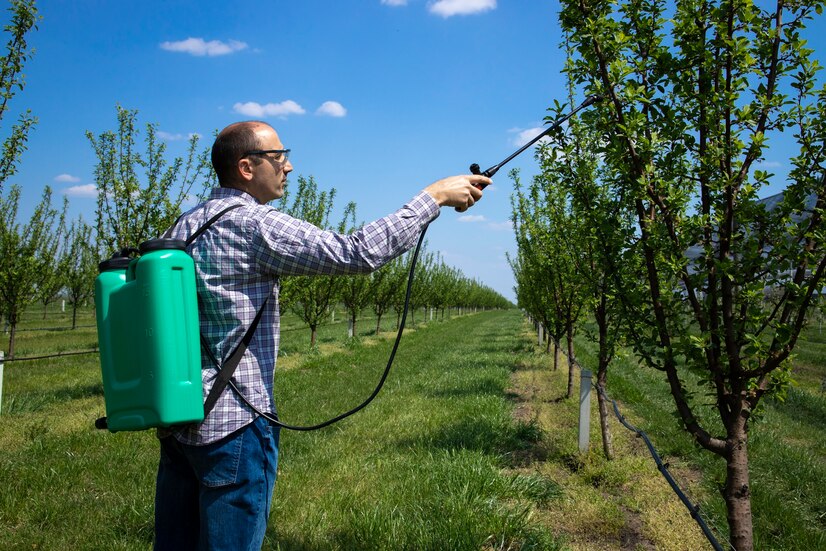These natural and do-it-yourself insecticides are excellent in ridding your crops of pests while remaining safe for you and your family.
There is no better way to appreciate the pains and sufferings of the farmers who provide our food than by cultivating a home garden. With weather, weeds, and insects, not to mention the challenges of soil fertility, it can be an incredibly humbling experience to try to feed oneself with a home garden – especially when adhering to organic protocols that do not rely on quick, but potentially harmful solutions, such as herbicides, pesticides, and conventional fertilizers. We have previously written about homemade herbicides, which may help you control noxious or invasive weeds with less effort than hand-weeding. This time, we’re focusing on insect pests, which have the ability to transform your previously lush garden into their own bug smorgasbord.
It is essential to remember that the fact that they are “natural” or homemade pesticides does not mean they cannot damage your soil, garden, or person. The EPA defines an insecticide as “any chemical intended to prevent, eradicate, repel, or mitigate pests,” and as such, insecticides have the potential to be “harmful to humans, animals, or the environment.” Moreover, not all insects are dangerous. Applying insecticides indiscriminately, particularly severe pesticides that kill even beneficial insects, may have a negative impact on the ecology of your garden.
Before going all-in with a pesticide or insecticide, make sure to do your research and choose the choice that is both the most effective and safest for you and your garden.

1. Vegetable Oil Spray
A homemade insecticide composed of vegetable oil and a mild soap (such as Dr. Bronner’s castile soap) may have a devastating impact on aphids, mites, thrips, and other pests.
To prepare a basic oil spray insecticide, combine one cup of vegetable oil with one tablespoon of soap (cover and shake well), and then, when ready to apply, combine two teaspoons of the oil spray mix with one quart of water, shake, and spray directly on the afflicted plant surfaces.
The oil covers the insects’ body, essentially smothering them since it clogs their breathing pores.
2. Soap Spray
A homemade pesticide very similar to the oil spray is a soap spray, which is similarly good against mites, aphids, whiteflies, beetles, and other insect pests.
Mix one and one-half tablespoons of a mild liquid soap (such as castile soap) with one quart of water, then spray the mixture directly on the affected surfaces of the plants to create a basic soap spray insecticide.
A soap spray insecticide functions similarly to an oil spray pesticide and may be sprayed as required (though it is always recommended to NOT apply it during the hot sunny part of the day, but rather in the early mornings or evenings).
3. Neem Oil Spray
The oil collected from the seeds of the neem tree is a potent natural insecticide that is capable of interrupting the life cycle of insects at all stages (adult, larvae, and eggs), making it a valuable resource for organic gardeners.
Neem oil disrupts hormones and serves as a “antifeedant” against insects that feed on leaves and other plant components. Neem oil is biodegradable and safe to pets, birds, fish, and other animals. It is also effective against a range of common garden insect pests and is a natural fungicide that may prevent powder mildew and other plant fungal problems. 3 Numerous garden shops and natural food markets carry it.
To use neem oil as an insecticide, either follow the directions on the package or begin with a combination of two teaspoons of neem oil and one teaspoon of mild liquid detergent in one quart of water, which is then sprayed on the damaged plant leaves. Neem oil may also be used preventatively by sprinkling it on the leaves of plants that are often attacked by pests, prior to an actual infestation.
4. Earth Diatomaceous
This natural material with a rather cumbersome name is derived from a sedimentary rock composed of fossilized algae (diatoms) and is a very plentiful resource (it is estimated that diatomaceous earth comprises 26 percent of the weight of the planet’s crust).
The usage of diatomaceous earth as a natural insecticide is only one of its many applications in and around the house. This material kills insects not by poisoning or suffocating them, but by virtue of its abrasive properties and its penchant for absorbing the lipids (a waxy substance) from their exoskeletons, causing them to dry and die.
If you have a tiny yard and can only get diatomaceous earth in huge bags, you may want to share it with a neighbor. Simply dust the soil around your plants or sprinkle it on the leaves to reduce snails, slugs, and other crawling pests. Due to its dry nature, diatomaceous earth must be reapplied after every rain in order to be an effective natural insecticide.
5. Garlic Spray
When garlic is utilized as a natural insecticide, its pungent odor, which is appealing to some but repulsive to others, plays an important role. Actually, it is unclear if garlic spray and chile spray (below) are insecticides or insect repellents, but regardless, these basic cooking items may be used to reduce or eliminate bug infestations in the garden.
To produce a simple garlic spray, combine two full bulbs (not just two cloves) with a tiny quantity of water in a blender or food processor. The next day, drain the mixture into a quart jar and add one-half cup of vegetable oil (optional), one teaspoon of mild liquid detergent, and sufficient water to fill the jar. To apply this homemade insecticide, combine one cup of the mixture with one quart of water and generously spray affected plants.
6. Chile Pepper Spray
Similar to garlic spray, chile pepper spray is an effective homemade natural insect repellent that may be used against a wide range of pests. Fresh spicy peppers or chile pepper powder may be used to create chile spray.
To create a simple chile spray from pepper powder, combine one tablespoon of pepper powder, one quart of water, and a few drops of mild liquid detergent. This combination may be applied at full strength to the damaged plants’ leaves. Blend or puree one-half cup of fresh chile peppers with one cup of water, then add one-quart of water and bring to a boil. Wait until the chile material has cooled, then sieve it, add few drops of liquid soap, and spray as desired.
Warning
Hot chile peppers may also be quite powerful for humans. Wear gloves while handling them, and keep sprays containing them away from your eyes, nose, and mouth.
7. All-in-One Homemade Spray
This all-in-one DIY natural insecticide originates from Rodale’s Organic Life and is reported to be a blend of several distinct reader-submitted recipes.
Blend one clove of garlic and one small onion, then add one teaspoon of cayenne pepper powder and let soak for one hour. Strain the mixture, then add one tablespoon of liquid soap and thoroughly combine. To apply this homemade insecticide, spray it on both the top and lower surfaces of the leaves, and if desired, keep the leftover in the refrigerator for up to one week.
8. Tomato Leaf Spray
This is a new one for me, but I’ve read enough references to it to justify its placement here as a natural insecticide. As members of the nightshade family, tomato plants possess alkaloids such as “tomatine,” which may successfully repel aphids and other pests. 5 To manufacture a natural insecticide from tomato leaves, cut two cups of fresh tomato leaves (from the bottom of the plant) into one quart of water and let soak overnight. Spray the strained plant material onto plant leaves.
Modify as Necessary
While there are many more organic pesticides accessible, including Bt (a soil microbe toxic to some insects), milky spore (also a microbe), nicotine (derived as a tea from bulk tobacco), pyrethrum (derived from a variety of daisies), and iron phosphate (a naturally occurring mineral poisonous to slugs and snails), the aforementioned natural and homemade insecticide formulas should serve as a good starting point for developing your own. By paying careful attention to the effects of a certain formula, you may tweak it to best fit your personal bug conflicts, since every organic farmer tends to use a different mixture and proportion of elements.
Any healthy ecosystem requires an abundance of beneficial insects, microbes, and fungi, both in the soil and on the plants themselves, so introducing other predatory insects (ladybugs, praying mantises, etc.) or creating a suitable habitat for them, as well as enhancing soil fertility, can also be effective pest management strategies.
- About the Author
- Latest Posts
A passionate advocate for all natural and sustainable ideas. With a background in sustainable economics science and a deep love for nature, Sojy has dedicated his career to promoting eco-friendly practices and encouraging others to live a more sustainable lifestyle. He is an avid hiker, gardener, and cook, and loves experimenting with natural ingredients in his recipes and lifestyle routines. Sojy believes that small changes can make a big impact and is constantly seeking out new ways to reduce his carbon footprint and inspire others to do the same



